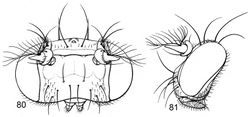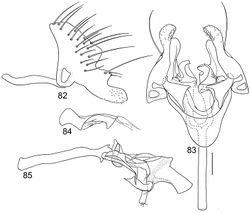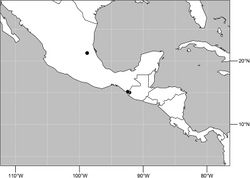Planinasus mcalpineorum
| Notice: | This page is derived from the original publication listed below, whose author(s) should always be credited. Further contributors may edit and improve the content of this page and, consequently, need to be credited as well (see page history). Any assessment of factual correctness requires a careful review of the original article as well as of subsequent contributions.
If you are uncertain whether your planned contribution is correct or not, we suggest that you use the associated discussion page instead of editing the page directly. This page should be cited as follows (rationale):
Citation formats to copy and paste
BibTeX: @article{Mathis2012ZooKeys225, RIS/ Endnote: TY - JOUR Wikipedia/ Citizendium: <ref name="Mathis2012ZooKeys225">{{Citation See also the citation download page at the journal. |
Ordo: Diptera
Familia: Periscelididae
Genus: Planinasus
Name
Planinasus mcalpineorum Mathis & Rung & Kotrba, 2012 sp. n. – Wikispecies link – ZooBank link – Pensoft Profile
Description of male
Moderately small to medium-sized flies, body length 2.45–3.15 mm.
Head (Figs 80–81): Head ratio 0.56–0.58; frons generally brownish black to black, mostly very finely and sparsely microtomentose, subshiny, except for densely microtomentose, velvet-like anterolateral angles; latter setulose; immediate anterior margin moderately microtomentose, dull; frons conspicuously wider than long, frontal ratio 0.35–0.36; interfrontal seta shallowly curved, elongate, length subequal to length of lateral vertical seta. Antenna brownish black to black; basal flagellomere moderately long, length conspicuously greater than width at base, tapered to moderately acute point at apex, both dorsal margin shallowly depressed; pedicel with ventral projection short, not extended anteriorly much beyond dorsal margin, bearing long, ventroapical seta (extended slightly beyond apex of basal flagellomere), 1 dorsal seta, 1 dorsomedial seta, 1 medial seta; arista bearing 13–14 dorsal rays, 3–4 ventral rays. Face comparatively wide, facial ratio 0.80–0.82; dorsad of transverse carina sparsely microtomentose, subshiny to shiny, mostly blackish brown, but dorsal margin partially yellowish; ventrad of transverse carina densely microtomentose, silvery white with some faint yellowish, sericeous; large facial setae not arranged in transverse row; medial pair of setae approximate, shallowly ventroclinate; next seta curved dorsally; next seta ventroclinate, inserted ventrad of medial pair; lateral 2 setae ventroclinate, slightly aligned vertically. Clypeus black with whitish gray microtomentum; palpus brownish black.
Thorax: Mesonotum generally brownish black to deep bluish black, sparsely microtomentose, subshiny to shiny; postpronotum brown with some yellowish coloration around margin; area from postpronotum and through notopleuron mostly bare, subshiny, at most finely microtomentose; pleural areas finely microtomentose, subshiny, blackish brown; anepisternum mostly bare but with 3–4 setulae along posterior margin; katepisternum generally setulose, bearing 2 setae toward dorsal margin. Wing without pattern, generally hyaline, only very slightly infumate. Coxae brown with gray to whitish gray microtomentum; trochanters yellowish brown to yellow; femora and tibiae uniformly brownish black; forefemur lacking a preapical annulus; tarsi mostly yellowish, apical 2–3 tarsomeres becoming darker; forefemur bearing 1 seta at apical 1/3 along posteroventral surface.
Abdomen: Uniformly blackish brown, mostly dull to faintly subshiny, modera-tely invested with microtomentum. Male abdomen: Tergites 1+2–6 well developed, lengths of 3–6 subequal; tergite 7 well developed but narrow, band-like; sternites 3–5 well developed, rectangular, wider than long, lateral margins shallowly arched; sclerotized posterior margin of sternite 5 very shallowly emarginate, very broadly V-shaped; sternite 6 apparently lacking; sternite 7 moderately well developed, wider than long, with an oblique, posterior, thumb-like, short process, sternite not fused with tergite 7 to form an annulus. Male terminalia (Figs 82–85): Epandrium in lateral view (Fig. 82) trapezoidal, higher than wide, narrowed dorsally, anterior margin shallowly emarginate, posterior margin shallowly sinuous; surstylus almost as long as epandrium, extended from ventral margin of epandrium in nearly oblique alignment with it, in lateral view (Fig. 82) wide, robustly developed basally, anterior margin shallowly arched, posterior distinctly and step-wise angulate, forming a medial angle bearing an elongate seta, apical half robustly developed, thumb-like; hypandrium in ventral view (Fig. 83) parallel sided, elongate, narrowly bar-like; postgonite in ventral view (Fig. 83) convoluted with short lobe, little extended, bearing 3 apical setulae, lobe in lateral view narrow, longer than wide; phallus in ventral and lateral views (Figs 83, 85) mostly membranous and difficult to discern; phallapodeme in lateral and ventral views (Figs 83) elongate, parallel sided, bluntly rounded apically; ejaculatory apodeme reduced, about as long as half that of phallapodeme, longer than wide, apex slightly dilated but not fan-like.
Description of female
As in male except as follows: Head generally narrower, head ratio 0.63–0.65; frontal ratio 0.43–0.45; facial ratio 0.49–0.53.
Type material
The holotype male is labeled “MEXICO: Chiapas[:] Cacahoatan, 7kmN[,] 22 April 1983[,] Wayne N. Mathis/USNM ENT 00118282 [plastic bar code label]/HOLOTYPE ♂ Planinasus mcalpineorum Mathis & Rung USNM [red]. The holotype is double mounted (minuten pin in a plastic block), is in excellent condition, and is deposited in the USNM. Five paratypes (1♂, 4♀; USNM) bear the same label data as the holotype. Other paratypes are as follows: MEXICO. Chiapas: Huixtla (NE; 15°10.3'N, 92°25.4'W; 915 m), 1 Jun 1969, H. J. Teskey (2♂; CNC). San Luis Potosí: Tamazunchale (near; 21°15.2'N, 98°47.3'W), 5 Aug 1962 (1♂, 1♀; USNM).
Type locality
Mexico. Chiapas: Cacahoatán (7 km N; 15°04.1'N, 92°07.4'W).
Distribution
(Fig. 86). Neotropical: Mexico (Chiapas, San Luis Potosí).
Etymology
The species epithet, mcalpineorum, is a Latin genitive patronym to honor both David K. McAlpine (Australia) and J. Frank McAlpine (Canada) for their numerous and excellent contributions to our knowledge of Acalyptrate Diptera.
Remarks
This species is known thus far only from southern Mexico. We suspect that it will be found to be more widespread once there is better sampling from other Central American countries. It is the only species of the nigrifacies group that has a conspicuously sclerotized ejaculatory apodeme.
Original Description
- Mathis, W; Rung, A; Kotrba, M; 2012: A revision of the genus Planinasus Cresson (Diptera, Periscelididae) ZooKeys, 225: 1-83. doi
Images
|


